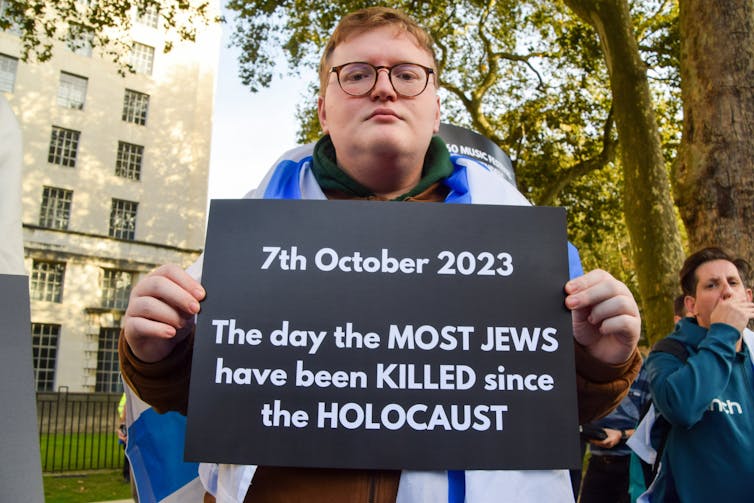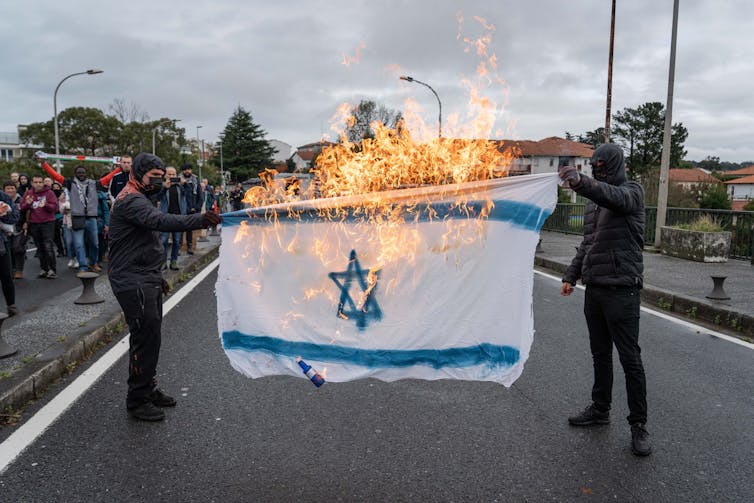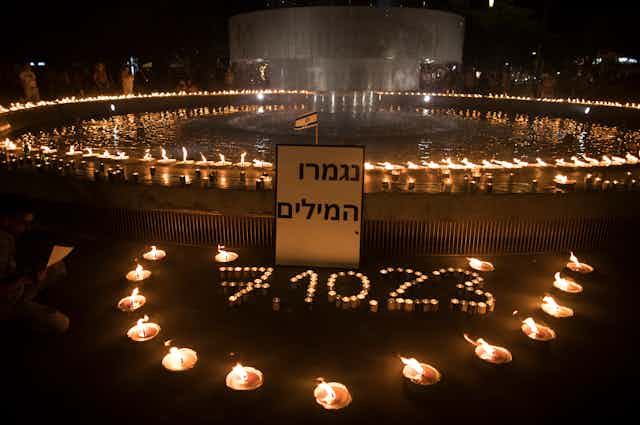Many observers have referred to the massacre of Israelis by Hamas on Oct. 7, 2023, as the deadliest attack against the Jewish people in a single day “since the Holocaust.”
As scholars who have spent decades studying the history of Israel’s relationship with the Holocaust, we have argued that the Holocaust should remain unique and not be compared with other atrocities. We have written against simplistic Holocaust analogies, like comparing mask and vaccine mandates during the COVID-19 pandemic to the Nazi persecution of the Jews, or the practice of labeling political opponents “Nazis.” Both seem to trivialize the memory of what is known as the Shoah, the Hebrew word for “catastrophe.”
But the Oct. 7 massacres perpetrated by Hamas changed our thinking.
Israeli identity and the Holocaust
Over the past 75 years, the collective memory of the Shoah has assumed a central place in Israeli national identity. The memory of the Holocaust has increasingly become the prism through which Israelis understand both their past and their present relationships with the Arab and Muslim world.
Israelis saw the Holocaust’s threat of annihilation echoed in many situations. In 1967, there was the waiting period before the Six-Day War, when the Egyptian leader Gamal Abdel Nasser threatened to “wipe Israel off the map.” It was there in the trauma of the Yom Kippur War in 1973 and the unexpected, simultaneous attacks by Egypt and Syria. When Israel destroyed the Iraqi nuclear reactor in 1981, Prime Minister Menachem Begin justified it with the explanation that “there won’t be another Holocaust in history.”
This association has only strengthened in the past 40 years with the 1982 Lebanon war, two Palestinian uprisings, known as intifadas, and with the present threat posed by a nuclear Iran.
All these events evoke the memory of the Holocaust and are understood within the collective memory of threats of annihilation. This phenomenon represents, for many Israelis, an inability to separate their current situation from the vulnerability of the diaspora Jewish past. And this conflation of past and present continues to play a central role in Israeli politics, foreign policy and public discourse.
The frequent comparisons between the Oct. 7 massacres and the Shoah are more, we believe, than just the default associations of a people submerged in Holocaust postmemory, which refers to inherited and imagined memories of subsequent generations who did not personally experience the trauma. In seeking to describe the depths of evil they witnessed on Oct. 7, Israelis were making more than just an emotional connection between the Holocaust and the Oct. 7 massacres.

To help explain the logic of that connection, specific and reasonable comparisons can be made to better understand Hamas’ traumatic and devastating massacre of Israelis. Below are a few of the many parallels:
1. Ideology and identification
Just as the Nazis aimed to annihilate the Jews, Hamas and affiliated terrorist organizations share the same objective: the destruction of Jews. The 1988 Hamas charter refers to “Jews” and not “Israelis” when calling for the destruction of these people.
While the 2017 Hamas covenant states that Hamas does not seek war with the Jews, but instead “wages a struggle against the Zionists who occupy Palestine,” the slaughter of Jews – many of whom were peace activists – in October has proven otherwise.
The national struggle of Hamas is predicated upon the conquest of land and elimination of the Jews. Hamas officials have subsequently promised to repeat Oct. 7 again and again until Israel is annihilated.
2. Indoctrination
While the racial antisemitism of the Nazi regime differs from the antisemitism employed in the fundamentalist Islamic version of Hamas, antisemitism is a key part of the struggle for both ideologies. Indoctrination from an early age aimed at the dehumanization of the Jews is a key part of both how Nazis taught young German students during the Third Reich and in how Hamas educates children in Gaza.
3. Methods of killing and survival
The horrors of Oct. 7 echo the brutal tactics Nazis used during the Holocaust, including not only murder but cruel humiliation of the victims. The testimonies of Oct. 7 survivors reveal the torture of parents and children, sometimes in front of each other, including rape and sexual violence, mocking and lingering in the murder process as the terrorists relished the atrocities they committed.
When the Jews in the Warsaw ghetto realized that the end was near, they worked for months to prepare hiding places for themselves in their homes and created improvised bunkers, doing whatever they could to avoid capture and deportation. They did not imagine that the Nazis would come to eliminate the ghetto in a different way, entering the ghetto with flamethrowers and burning down one building after another. Some Jews were burned alive, while others fled outside and fell into the hands of the Nazis.
On Oct. 7, victims in the kibbutzim and communities near Gaza hid in fortified safe rooms designed to protect them from rocket attacks. Hamas terrorists went from house to house, burning one after the other so that inhabitants would be forced to flee from their protected shelters. Others were burned in their homes.

4. Using Jews in the killing process
On Oct. 7, Hamas terrorists took a hostage from Nahal Oz, one of the kibbutzim in the south, and forced him to go from house to house to knock on doors and lure his neighbors outside. Afterward, they murdered him. Holocaust scholars have described such episodes from World War II in which Jews were forced to cooperate as “choiceless choices.”
5. Terminology
The word Shoah is used in the Bible to describe danger from neighboring nations, signifying distress, pain, torment, calamity and a “day of destruction.” While it later came to define the total Nazi extermination of Jews in the 1940s, multiple testimonies collected from survivors of the Oct. 7 massacres use the term once again today, echoing the biblical definition, to signal a day of desolation, darkness, destruction and gloom.
The words used to describe events are often loaded with emotional associations; the power and meaning of words that attempt to convey the depths of traumatic experiences cannot be discounted.
Not the same
There is a difference between pointing out similarities and creating shallow comparisons. We are aware of the tendency, especially in the political sphere, to resort to simplistic, symbolic and performative comparisons to the Holocaust – such as Israel’s ambassador to the United Nations, Gilad Erdan, donning a yellow star with the words “Never Again” on Oct. 31.
Oct. 7 is not the same as the Holocaust. Even so, we can use the study of the Holocaust to understand the traumatic and devastating encounters between Hamas terrorists and their victims on Oct. 7.
It might be a trivialization of the Holocaust to simply label Hamas as the “new Nazis,” but our analysis reveals that recognizing their eliminationist antisemitism means there can be no return to the pre-Oct. 7 status quo, when Israel’s policy was to accommodate Hamas’ control of the Gaza strip.
Despite the natural tendency to turn away from the most shocking and the most horrific manifestations of human evil, there are times when gazes must not be averted, when horror must be confronted in order to understand the motivations of the perpetrators and the responses of the victims and the survivors.
In this case, at what point do we ignore analogies that seem deliberate and intentional? As Holocaust scholars, we recognize why Israelis are stuck – and struck – by the traumatic nature of Oct. 7.

